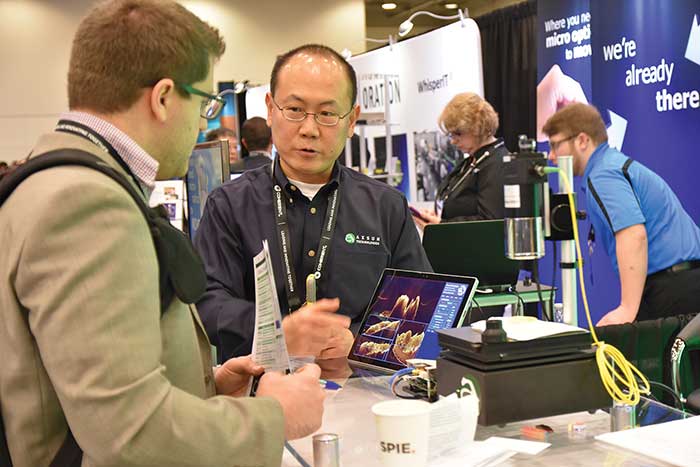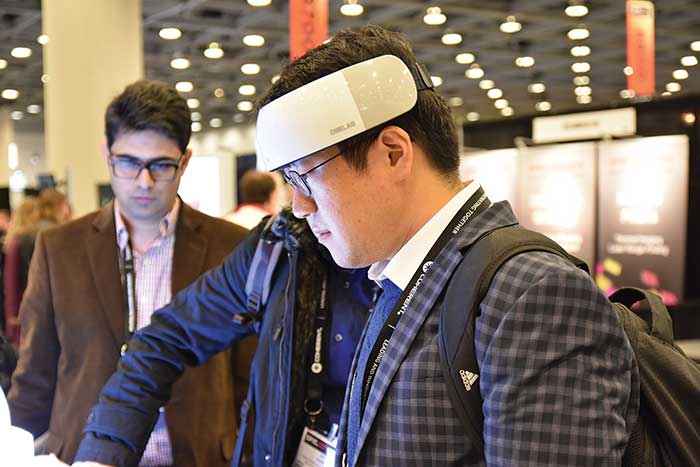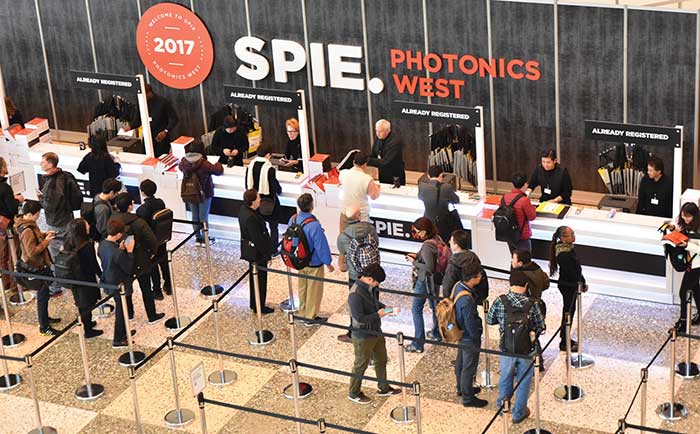SPIE BiOS has been hailed “the most important biomedical optics conference you can attend in 2018.” The world’s largest biophotonics, biomedical optics and imaging conference, it offers the latest research on topics such as biomedical optics, diagnostics and therapeutics, imaging modalities, neurophotonics, optogenetics and tissue optics, as well as the presentation of 2400 papers. It will be held at the Moscone Center in San Francisco on Saturday, Jan. 27, and Sunday, Jan. 28.

Companies from around the world will showcase their bio-focused products and technologies at SPIE BiOS. Courtesy of SPIE.
“There is a whole different feel and buzz to BiOS Expo. The buzz I’m hearing on the floor at BiOS is better than any show I’ve ever done in any industry,” said Ramont Turnbull, business development manager at Fiberguide Industries. “It is so nice to hear the din of a lot of people talking, discussing ideas and learning about new products all over the hall.”
The BiOS conference is separated into six tracks:
• Photonic Therapeutics and Diagnostics (chair: Brian Jet-Fei Wong, Beckman Laser Institute and Medical Clinic at the University of California, Irvine)
• Neurophotonics, Neurosurgery and Optogenetics (chairs: Rafael Yuste of Columbia University; David Boas, Massachusetts General Hospital and Harvard Medical School)
• Clinical Technologies and Systems (chairs: Tuan Vo Dinh, Fitzpatrick Institute for Photonics at Duke University; Anita Mahadevan-Jansen, Vanderbilt University)
• Tissue Optics, Laser-Tissue Interaction and Tissue Engineering (chair: Steven L. Jacques, Oregon Health & Science University)
• Biomedical Spectroscopy, Microscopy and Imaging (chairs: Ammasi Periasamy, University of Virginia; Daniel L. Farkas, University of Southern California and Spectral Molecular Imaging Inc.)
• Nano/Biophotonics (chairs: Paras Prasad, SUNY Buffalo; Dan V. Nicolau, McGill University)
Courses, workshops
Each track will offer numerous courses and educational sessions focusing on a range of areas — from lasers in dentistry and adaptive optics to wavefront control for biological systems and biomedical detection. Specific sessions include Endoscopic Microscopy, Neural Imaging and Sensing, Design and Quality for Biomedical Technologies, Photons Plus Ultrasound, Single-Molecule Spectroscopy and Superresolution Imaging, and Plasmonics in Biology and Medicine.

Demonstrations will bring a variety of innovations to life during the BiOS conference. Courtesy of SPIE.
Industry workshops provide the photonics-related basics for nontechnical players in laser materials processing such as “How to Speak High-Power Diode Laser,” as well as where to start with concurrent optomechanical engineering, laser optics and polarizers, Raman spectroscopy and even marketing tips.
Snapshot courses target industry and nontechnical staff, as well, with Basic Optics for Non-Optics Personnel, The Very Least You Need to Know about Optics, and the Fundamentals of Optical Engineering, among others.
Other speakers and course leaders are BiOS symposium co-chair James G. Fujimoto, a professor at MIT and member of the SPIE Board of Directors; Alexis Vogt, a renowned optics expert and professor at Monroe Community College in Rochester, N.Y.; Cheryl G. Asbury, of the NASA Jet Propulsion Laboratory; Paul O. Leisher, of Lawrence Livermore National Laboratory; Microsoft Corp.’s Bernard C. Kress; and Kevin G. Harding from GE Global Research.
Hot Topics
Scheduled for Jan. 27, the Hot Topics program brings together industry experts who present 10-minute talks on major breakthroughs in biophotonics and health care technology. Breakthroughs in photodynamic therapy, optical metabolic imaging, OCT for oral imaging applications, and 3D multiphoton optogenetic technology for neural ensemble activity are on tap during this portion of BiOS. Some specific topics include Brainsmatics: Visualizing Brain-wide Networks; Biophotonics for GASMA spectroscopy; and Large-Scale Single-Cell Analysis with Extreme Imaging. Speakers hail from the Wellman Center for Photomedicine at Massachusetts General Hospital, Tufts University, Technical University Dresden and the University of Tokyo, among others.
Plenary sessions will be held here, too. Among them is Superresolution Post-Nobel, presented by 2014 Nobel Laureate (Chemistry) Stefan W. Hell of the Max Planck Institute Gottingen. Others include:
• Neurophotonic Strategies for Observing and Controlling Neural Circuits
Presenter: Ed Boyden, MIT
• Optical Assessment of Cerebral Autoregulation
Presenter: Sergio Fantini, Tufts University
• Photobiomodulation and the Brain: A New Clinical Paradigm
Presenters: Michael Hamblin, Wellman Center for Photomedicine; Elizabeth Hillman, Columbia University; and Song Hu, University of Virginia
• Fast In-Vivo Volumetric Imaging of the Brain
Presenter: Na Ji, University of California, Berkeley
• Optics and Photonics for BRAIN Science: BRAIN Initiative Funding Priorities
Presenter: Edmund Talley, National Institutes of Health
Hot Topics is also the time when SPIE presents the Britton Chance Biomedical Optics Award, which annually recognizes “outstanding lifetime contributions to the field of biomedical optics through the development of innovative, high-impact technologies.” In particular, the award honors pioneering contributions to optical methods and devices that have facilitated advancements in biology or medicine.
The 2018 recipient is Tayyaba Hasan. She is a professor of dermatology at the Wellman Center for Photomedicine at Massachusetts General Hospital (MGH) and Harvard Medical School, and a professor of health sciences and technology at Harvard-MIT. Hasan is also the former director of the MGH Office for Research Career Development. She focuses her scientific efforts on photochemistry-based methods, including photodynamic therapy, for treatment and diagnosis of disease. Hasan was chosen to receive the award based on her achievements in such work.

SPIE BiOS, which kicks off Photonics West, is hailed “the most important biomedical optics conference you can attend in 2018.” Courtesy of SPIE.
“[Being] named the Britton Chance Award recipient is a great honor for me. Britton Chance was an inspiring renaissance man who stimulated many new ideas, and it is a joy to be recognized by an award named after him and to be in the company of the distinguished previous recipients, each one of whom I hold in high esteem,” Hasan said. “In the future, I hope to see more X-chromosomal representation on this illustrious list. I am most grateful to the nominators, letter writers, SPIE and the selection committee.”
MIT’s Fujimoto and fellow BiOS symposium chair Dr. R. Rox Anderson, of Massachusetts General Hospital’s Wellman Center for Photomedicine and Harvard Medical School, will also speak during the Hot Topics program.
Best Paper Awards
The work of students and young researchers is recognized at BiOS with several awards. Those being honored are announced during the conference. Cash prizes accompany these recognitions.
Ophthalmic Technologies is the focus of the 2018 Pascal Rol Best Paper Award, and it is judged based on the most “outstanding extended abstracts” on this specific topic. The 2017 recipient of this award was Furu Zhang of Indiana University.
The 2018 Seno Medical Instruments Best Paper Award recognizes those working in Photons Plus Ultrasound: Imaging and Sensing. The Journal of Biomedical Optics and Neurophotonics offers a 3-Minute Poster Award for students — where they can present a three-minute rapid-fire overview of their poster research — based on content and presentation effectiveness. Another poster session competition draws attention to Multiphoton Microscopy in the Biomedical Sciences.
Several Best Student Paper awards will be handed out, with focuses on Diseases in the Breast and Reproductive System; Microfluidics, BioMEMS and Medical Microsystems; and Optical Diagnostics and Sensing: Toward Point-of-Care Diagnostics. Also to be presented during BiOS will be the Picoquant Young Investigator Award (Single Molecule Spectroscopy and Superresolution Imaging), the Prizmatix Young Investigator Awards (Nanoscale Imaging, Sensing and Actuation for Biomedical Applications), and the Ocean Optics Young Investigator Award (Colloidal Nanocrystals for Biomedical Applications).
All researchers in the area of High-Speed Biomedical Imaging and Spectroscopy: Toward Big Data Instrumentation and Management will have a chance at the Best Paper Awards. Six papers will be chosen to receive prizes sponsored by Hamamatsu, PiPhotonics Inc. and Hitachi High-Tech.
For more information about SPIE BiOS 2018, visit spie.org. And on Saturday, Jan. 27, at 3 p.m., stop by the Photonics Media booth 8735 to meet and talk with Marcia Stamell, Photonics Media associate managing editor and editor of BioPhotonics magazine.
SPIE BiOS 2018 Exhibition
The BiOS expo — held concurrently with the BiOS conference on Saturday, Jan. 27, and Sunday, Jan. 28 — is considered the world’s largest biomedical optics and biophotonics exhibition, with 200+ exhibiting companies focused on technologies such as biomedical optics, lasers, molecular imaging, therapeutic lasers, nano/biophotonics, biosensors and spectroscopic/microscopic imaging.
Exhibitors include:
Boston Micromachines Corp.
Cobolt AB
ESPROS Photonics AG
Fresnel Technologies Inc.
Applied Scientific Instrumentation Inc.
LaCroix Precision Optics
Syntec Optics
Viavi Solutions
Laser Quantum Inc.
HUBNER Group GmbH
Meadowlark Optics Inc.
JenLab GmbH
OPOTEK Inc.
Grace Laser
PCO-TECH Inc
Raptor Photonics Ltd.
YSL Photonics
Mad City Labs Inc.
HILLTOP Technology Laboratory Inc.
Diode Laser Concepts Inc.
For a full list of exhibitors, visit www.spie.org.
Innovative products and technologies will take the stage with several demonstrations throughout the expo. Among them is the Flexible Wavelength Selector, presented by Marcus Noble of Spectrolight Inc., which combines the wavelength tuning of a monochromator with the large circular aperture typical of an optical filter. Another is a new high-spatial-resolution hyperspectral camera that will be demonstrated by Oliver Pust of Delta Optical Thin Film A/S; it is based on a continuously variable filter.